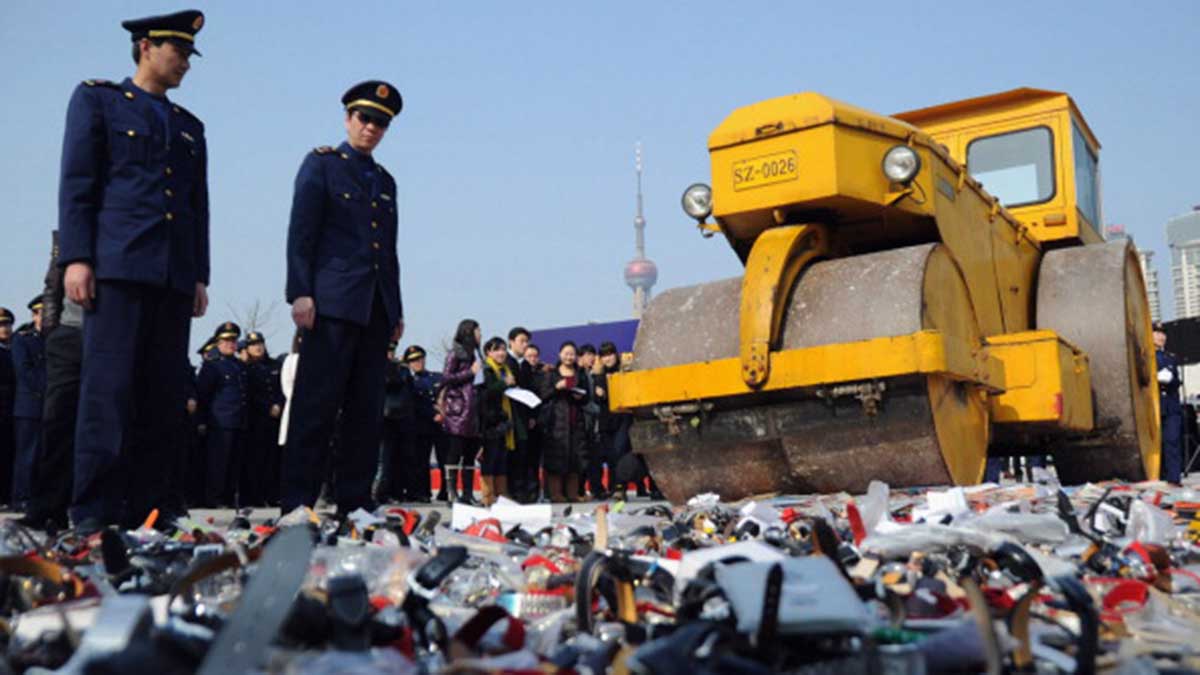Alarming growth in Asian counterfeiting drives demand for YPB’s high-tech QR codes

Chinese authorities look on as a road roller crushes counterfeit products in Shanghai. Pic: Getty
Special Report: Brand protection and anti-counterfeiting expert YPB is using enhanced QR code technology to combat an alarming growth in counterfeiting across Asia.
QR (Quick Response) codes are machine-readable labels that can contain 300 times more information than a standard bar code.
The ubiquitous codes are used in Asia for everything from product-tracking to item identification and marketing. A user simply scans a code with a smartphone and is directed to information on the product.
YPB is using advanced, high-tech QR technology to fight a steep growth in counterfeit goods.
Counterfeit goods account for about 2.5 per cent of global trade — or the equivalent of $540 billion, according to the Organisation for Economic Co-operation and Development (OECD).
“That’s equivalent to more than twice the annual revenue of Apple Inc – and the number is growing,” OECD senior economist Piotr Stryszowski told The Edge Financial Daily this year.
In the past, counterfeiters targeted mainly luxury goods. Now household products such as batteries, toothpaste, vitamins and cosmetics are commonly copied — which is driving demand for solutions such as YPB’s QR code technology.
Fight against fakes
YPB is focused heavily on fighting fakes in China.
“In China, QR codes drive everything but they are largely misunderstood in Australia,” chief John Houston told Stockhead.
“The reliance on QR codes has been driven by necessity and are an easy way for Asian consumers to verify the authenticity of a product — especially the in-demand Aussie cosmetics and vitamins.”
The two joined forces as Chinese demand for Australian goods continues grow – ensuring Aussie items a level of intellectual property protection, that they are what they say they are by the time they reach a customer.
“More than just QR codes themselves, there is a growing need for those codes to be protected,” he said.
“The difference in how we see QR codes is that we can protect them physically using our traceability tech to provide a higher level of security.”
Under the Australian Made agreement, YPB will offer its full “PROTECT DETECT CONNECT” product suite to all its 2700-plus Australian licencees.
QR crackdown
YPB’s QR protection technology helps prevent the use of fake QR codes. The Chinese Central Bank recently put a limit on transactions using QR codes, which restricts mobile purchases using the tech over 500 yuan (roughly $80) due to the rising instances of fake QR codes.
Similar to tap-and-go transactions in Australia – QR codes are linked to WeChat or AliPay accounts for increased security but without the need for a credit card.
The technology has come a long way since its invention in 1994 by Japanese car-makers — but Mr Houston says brands should use the latest QR technology to ensure protection.
“Aussie brands need to protect their products against counterfeit and YPB’s PROTECT codes do that and at the same time allow brands to directly link to consumers, especially in Asia.
“The lack of adoption of the technology will become problematic in time for those companies wishing to grow their market share into the world’s largest market.”
This special report is brought to you by YPB Group.
This advice has been prepared without taking into account your objectives, financial situation or needs. You should, therefore, consider the appropriateness of the advice, in light of your own objectives, financial situation or needs, before acting on the advice.
If this advice relates to the acquisition, or possible acquisition, of a particular financial product, the recipient should obtain a Product Disclosure Statement (PDS) relating to the product and consider the PDS before making any decision about whether to acquire the product.
UNLOCK INSIGHTS
Discover the untold stories of emerging ASX stocks.
Daily news and expert analysis, it's free to subscribe.
By proceeding, you confirm you understand that we handle personal information in accordance with our Privacy Policy.








